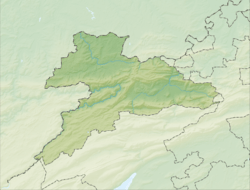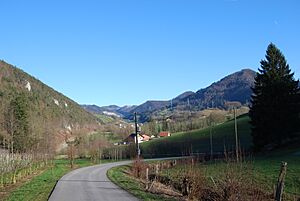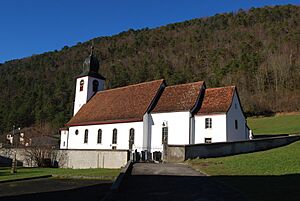Vermes, Switzerland facts for kids
Quick facts for kids
Vermes
|
||
|---|---|---|

Vermes village
|
||
|
||
| Country | Switzerland | |
| Canton | Jura | |
| District | Delémont | |
| Area | ||
| • Total | 18.32 km2 (7.07 sq mi) | |
| Elevation | 566 m (1,857 ft) | |
| Population
(2011)
|
||
| • Total | 321 | |
| • Density | 17.52/km2 (45.38/sq mi) | |
| Postal code |
2829
|
|
| Surrounded by | Rebeuvelier, Vicques, Courchapoix, Corban, Mervelier, Schelten(BE), Elay(BE), Corcelles(BE), Crémines(BE) | |
Vermes (pronounced "vairm") was once a small town, called a municipality, in the Jura canton of Switzerland. It was located in the Delémont district. On January 1, 2013, Vermes joined with two other towns, Montsevelier and Vicques. Together, they formed a new, larger municipality called Val Terbi.
Contents
History of Vermes
We don't know much about the very early days of Vermes. The town was first mentioned in old writings in the year 769. It was called Verteme back then. This name might have come from an old Gaulish word, vertima, which means "mountain top." Later, in 866, it was still called Vertima, and by 1308, it was known as Vermunt.
The Saint Paul Monastery
The village of Vermes actually grew around the Saint Paul monastery. This monastery was built in the 600s by monks from the order of Saint Columban. The abbot (leader) of Luxeuil Abbey, Saint Waldebert, put Saint Germanus of Granfelden in charge of the Moutier monastery. He also gave him the smaller monasteries of Vermes and Saint-Ursanne to look after.
Saint Germanus led these monasteries for 35 years. During this time, they grew and became very successful. In the 800s, the original rules of Saint Columban were changed. The Saint Paul monastery then became a Benedictine monastery. After almost 300 years, the Saint Paul monastery in Vermes probably closed down around the year 962. This was likely done by the sons of Liutfried VI, who was a count. You can still see the remains of the monastery today in an area called Sur les Clos in Vermes.
Geography and Nature
Vermes covered an area of about 18.32 square kilometers (about 7.08 square miles). A large part of this land, about 38.7%, was used for farming. Even more, about 56.9%, was covered by forests.
A smaller part of the land, about 3.6%, had buildings or roads on it. A tiny bit, 0.2%, was rivers or lakes. The remaining 0.3% was land that couldn't be used for farming or building. Most of the forested land was dense forest, and some had orchards or small groups of trees. The farmland included areas for growing crops, pastures for animals, and high mountain pastures. All the water in Vermes was flowing water, like streams.
What Makes Up Vermes?
The former municipality of Vermes is located in the Delémont district, in a valley called Val Terbi. It includes the main village of Vermes. It also has a small settlement called Envelier and the historic Raymontpierre Castle.
Vermes Coat of Arms
The coat of arms for Vermes is described as: Or, a Bend Azure between two Trefoils Vert in bend counterposed. This means it has a gold background (Or). There is a blue stripe (Bend Azure) running diagonally across it. On either side of the blue stripe are two green clover leaves (Trefoils Vert). They are placed diagonally in opposite directions.
People and Population
In 2011, Vermes had a population of 321 people. A small number of these residents, about 3.9% in 2008, were foreign nationals. Over ten years (from 2000 to 2010), the population of Vermes grew by 7.8%. More people moved into the town than left it, which helped the population grow.
Most people in Vermes speak French as their main language, about 69.6% in 2000. German was the second most common language, spoken by about 28.2% of the people. A small number, 1.6%, spoke English.
In 2008, a little more than half the population (52.1%) was male, and 47.9% was female. Most residents were Swiss citizens. In 2000, about 41.7% of the people living in Vermes were actually born there. Another 17.6% were born in the same canton (Jura). About 27.6% were born elsewhere in Switzerland, and 9.4% were born outside of Switzerland.
In 2000, children and teenagers (ages 0–19) made up about 24.5% of the population. Adults (ages 20–64) were the largest group at 56.4%. Seniors (over 64 years old) made up 19.1% of the population.
Population Changes Over Time
The chart below shows how the population of Vermes has changed over many years:

Economy and Jobs
In 2010, the unemployment rate in Vermes was quite low, at 2.5%. In 2008, many people worked in the primary economic sector. This sector includes jobs like farming and forestry. There were 58 people working in this area, with 19 businesses.
A smaller number of people, 7, worked in the secondary sector. This includes jobs like manufacturing. There were 3 businesses in this sector. The tertiary sector had 25 people working in it, with 11 businesses. This sector includes services like sales, hotels, and education.
In 2008, there were 66 full-time equivalent jobs in Vermes. Most of these, 44 jobs, were in the primary sector, mainly agriculture. Six jobs were in manufacturing. The tertiary sector had 16 jobs. Half of these were in hotels or restaurants. A quarter were in sales or vehicle repair, and some were in education.
In 2000, 9 people traveled into Vermes for work, while 82 people traveled out of Vermes for their jobs. This means more people left Vermes to work than came in. About 9.6% of working people used public transportation to get to work, and 52.7% used a private car.
Religion in Vermes
According to the 2000 census, most people in Vermes were Roman Catholic, about 57.7%. Another 13.2% belonged to the Swiss Reformed Church. About 26.33% of the population belonged to other Christian churches. A very small number, about 0.63%, were Islamic. Some people, about 11.60%, did not belong to any church or were agnostic or atheist.
Education System
In Vermes, about 31.7% of the population had finished upper secondary education. This is education after primary school but before university. About 7.2% had gone on to higher education, like a university or a specialized college (Fachhochschule).
The Canton of Jura has a specific school system. It starts with two years of optional Kindergarten. After that, students go to six years of Primary school. Then comes three years of required lower Secondary school. In this stage, students are grouped based on their abilities. After lower Secondary, students can choose to go to an optional upper Secondary school for three or four years. They can also go to a Tertiary school or start an apprenticeship (learning a trade on the job).
During the 2009–10 school year, 26 students attended 2 classes in Vermes. There were no kindergarten classes in the town. Vermes had 2 primary classes with 26 students. Since there are only nine Secondary schools in the whole canton, students from Vermes go to secondary school in a different town. In 2000, 27 students from Vermes went to schools outside the municipality.
See also
 In Spanish: Vermes para niños
In Spanish: Vermes para niños








